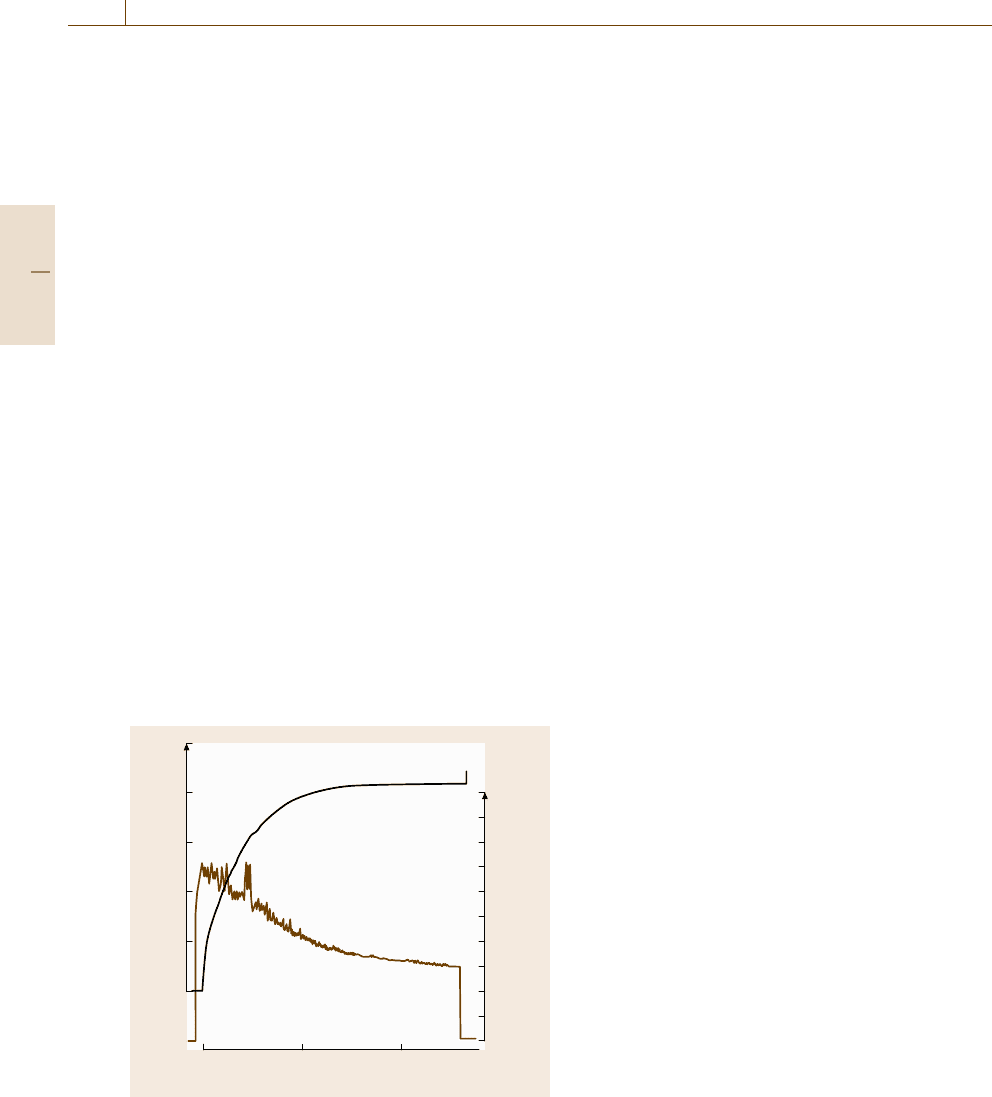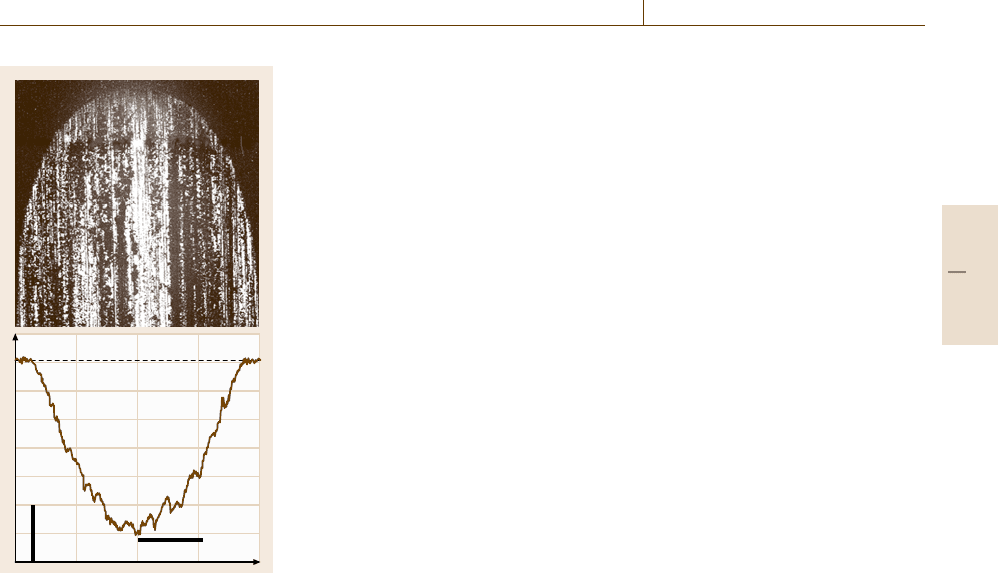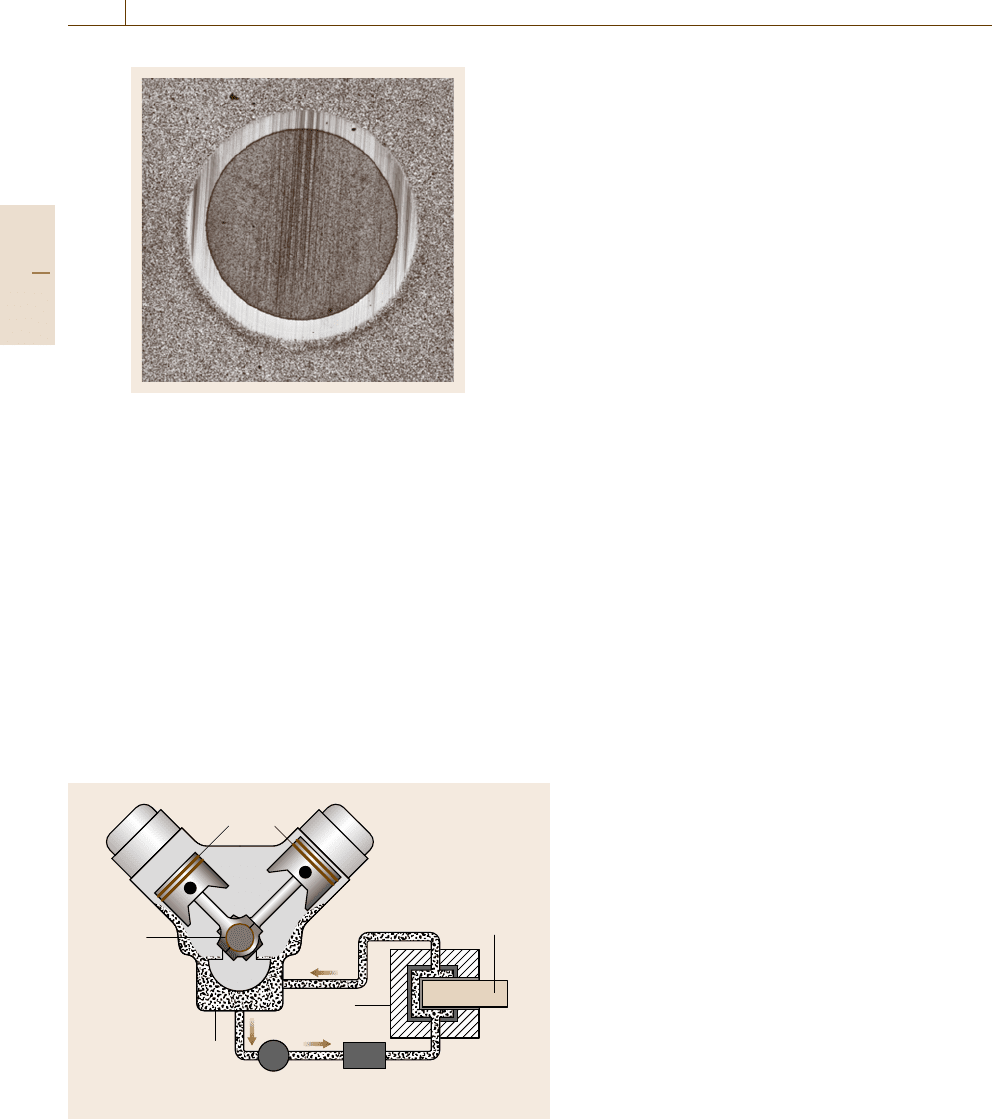Czichos H., Saito T., Smith L.E. (Eds.) Handbook of Metrology and Testing
Подождите немного. Документ загружается.


758 Part D Materials Performance Testing
Normal force (N) /Friction force (N) /
Total displacement (μm)
Normal force (N)
Friction force (N)
Total displacement (μm)
Ball: Al
2
O
3
Disc: Al
2
O
3
Velocity: 0.1 m/s
10 N
50 %
FN:
r.H.:
0 10 000
Time (s)
10
5
0
15
–10
–5
8000600040002000
Table 13.3 Tribological tests involving sliding motion
Test Parameters
Materials composition and microstructure
Load
Speed
Temperature
Surface condition
Environment
Lubrication
Contact time and interval between loading of contact areas on
two samples
Measurements
Direct change of dimension
Volume (usually via weight loss and density)
Profilometry
Friction
Continuous measurement of wear during test
Examination of worn surface
Examination of wear debris
Standards
ASTM G99
ASTM G 133
ISO 20808
segments (2 +4). The calibration of the relevant spring
constants of the cantilever (in bending and torsion) is
not a trivial procedure [13.16–18].
A technique known as triboscopy monitors the evo-
lution of time-dependent local phenomena with a spatial
Fig. 13.14 Example of online measurement of linear wear
(total displacement of ball relative to disc) and friction
force for continuous sliding of an alumina ceramic ball on
an alumina disc
Table 13.4 Tribological tests involving rolling motion
Test Parameters
Materials composition and structure
Load
Relative slip of rolling elements
Rolling speed
Temperature
Surface condition
Environment
Lubrication
Measurements
Direct change of dimension
Volume (usually via weight loss and density)
Profilometry
Torque
Continuous measurement of wear during test
Examination of worn surface
Examination of wear debris
resolution limited by contact size. With this technique,
complementary images of the friction force can be ob-
tained by simultaneously recording spatially-resolved
electrical contact resistance and friction measurements.
The technique provides information about the his-
tory of friction and wear processes [13.19]. When
measuring the electrical contact resistance, care must
be taken that the electrical sensing current remains
low, because otherwise the wear process may be
influenced.
13.4.7 Presentation of Results
In most cases the specification of a single coefficient
of friction is not adequate. This can be seen from the
examples in Figs. 13.12 and 13.14, depicting the evo-
lution of friction during individual experimental runs.
At the very least, all relevant test and system pa-
rameters should be specified. The list in Table 13.1
provides a general guide, and is supplemented by
the more specific lists of parameters in Table 13.3
and Table 13.4.
Part D 13.4

Friction and Wear 13.5 Quantitative Assessment of Wear 759
13.5 Quantitative Assessment of Wear
13.5.1 Direct and Indirect Quantities
The amount of wear can be specified in terms of direct
or indirect quantities.
Indirect quantities are often used in technical as-
sessments of the lives of machinery and in practical
engineering. Examples include
•
wear-limited service life (used for cutting tools for
example: h, d, number of parts)
•
wear-limited throughput (used for the flow of abra-
sive materials or objects through pipelines for
instance: number of parts, m
3
, kg).
Direct wear quantities specify the change in mass, geo-
metrical dimensions or volume of the wearing body.
Examples include
•
wear amount:
– mass loss (kg)
– linear dimensional change (m)
– volume loss (m
3
)
•
wear resistance = 1/(wear amount) (m
−1
,m
−3
,
kg
−1
)
•
wear rate = (wear amount)/(sliding distance or
time) (m/m, m
3
/m, kg/m, m/s, m
3
/s, kg/s)
•
wear coefficient, or specific (or normalized) wear
rate (also sometimes called wear factor) = (wear
rate)/(normal force) (m
3
N
−1
m
−1
).
The primary measurement from which these quantities
are derived is usually mass loss, dimensional change or
volume loss, although other methods can also be used
(see Sect. 13.5.5).
13.5.2 Mass Loss
The loss of substance from the surface of a triboelement
can be determined by weighing it before and after wear.
Continuous sensing of the wear process in terms of mass
loss is usually not possible. Mass loss measurement at
defined intervals, to obtain information about the devel-
opment of wear (and hence to investigate running-in,
stability of wear rate, and so on), require the test to be
halted and the triboelement(s) removed for weighing. In
this process the danger exists that the microcontact ge-
ometry will be changed on reassembly. Such a change
in microgeometry can influence the wear rate. Debris
present in the contact region is also likely to be dis-
turbed, and often removed. The most important period
in the development of the wear rate may be missed, and
the act of interrupting the test in order to weigh the spe-
cimen may alter the progress and even the predominant
mechanism of wear.
The sensitivity of this method of wear quantifica-
tion is relatively low. The method is applicable only
for wear rates high enough that a significant mass loss
(typically of the order of at least 1 mg) is reached af-
ter a reasonable time for a test sample not heavier than
about 0.5 kg. For materials which experience significant
mass changes from other causes, such as the absorption
or loss of water by certain polymers, or the oxidation
of metals at high temperatures, special care must be
taken to ensure that the mass changes measured are gen-
uinely associated with tribological processes and are
not due to other phenomena. Suitable control speci-
mens, not subjected to wear but otherwise exposed to
the same conditions as the triboelements, may be help-
ful for eliminating such effects and also for correcting
for any long-term drift in the calibration of the balance.
The accuracy of weighing may be limited by the ac-
curacy or sensitivity of the balance (especially in the
case of heavy triboelements), by changes in humidity
between the two weighings, or by particle or debris at-
tachment or detachment. Material transfer and oxidation
during the wear process often complicate the interpreta-
tion of the measured mass values and can sometimes
lead to erroneous interpretation of the wear behavior.
Wear is sometimes expressed in units of volume,
and in order to convert mass loss to volume loss, the
density of the worn material must be known. For a ho-
mogeneous bulk material this will usually pose no
problems, but if wear is occurring from a coating or
treated surface layer then the relevant density may not
be accurately known.
13.5.3 Dimensional Change
Changes in linear dimensions due to wear are frequently
measured on-line (continuously) during friction tests.
This has advantages over making measurements by in-
terrupting the test, because one can then get information
about the continuous evolution of wear during the test
and, by detecting transitions in the measured linear wear
rate, about changes in the dominant wear mechanism.
In most cases a change in the distance between the
mounting fixtures of the two triboelements is meas-
ured. This implies that only the sum of the linear wear
contributions from both elements can be obtained. Ma-
terial transfer from one triboelement to the other may
Part D 13.5

760 Part D Materials Performance Testing
lead to misinterpretation. For example, in the frequently
used test arrangement with a ball or pin sliding contin-
uously on a disc surface, transfer of material from the
disc to the ball will change the distance between them.
Depending on the amount of wear of the disc or the ra-
tio of wear to transfer, the measured distance can be
reduced, eliminated or increased. This last case may oc-
cur if much of the material worn from the larger wear
scar on the disc is transferred to the smaller wear area
on the ball or pin. Figure 13.14 shows an example of
such behavior for an alumina ball sliding on an alumina
disc. For up to about 3500 s of sliding, the displace-
ment of the sample increases steadily, with the system
apparently showing negative wear. The reason for this
is that wear debris is accumulating in the contact re-
gion. The agglomerated particles of worn material then
suddenly detach, leading to a negative total displace-
ment, which is then followed by further accumulation
of debris. The friction force also changes, which is
associated with a change in the nature of the surface
interaction.
In some cases wear of one or both triboelements
leads to a significant change in the local geometry
of the contact. An example of this behavior is shown
in Fig. 13.15. As wear occurs on the steel ball the
contact area progressively increases, and the wear rate
detected in terms of a change in the distance between
the two triboelements falls rapidly with time, although
the associated volume wear rate varies much less. In
40
30
20
10
50
0
1.0
Time t (h)
Coefficient of friction f
f
Linear wear W
1
(µm)
0.8
1
0.6
0.4
0.2
0
0 0.5
W
1
Fig. 13.15 Example of online measurement of linear wear
(total displacement of ball relative to disc W
l
) and friction
force ( f ) for reciprocating steel ball on a diamond-coated
disc (courtesy of D. Klaffke)
this experiment there was also a substantial change in
friction force.
For on-line measurements of the changes in linear
dimensions or displacements, inductive or capacitative
sensors are frequently used. Inductive sensors can attain
aresolutiondownto1μm, and capacitative sensors can
reach a resolution in the nanometer range. Both types
of sensors and their associated electronic circuits ex-
hibit some temperature drift and a limited bandwidth
(frequency range over which the defined specification
of repeatability, resolution and accuracy is achieved).
However, in most cases, the dimensional changes due
to temperature variations in the test samples, their fix-
tures, and the mechanical construction of the apparatus
induce greater measurement errors than those of the
sensor system itself. Capacitative displacement sensors
require a relatively clean environment: dirt, dust, water,
oil or other dielectric media in the measuring gap will
influence the measurement signal. Inductive sensor sys-
tems are generally less expensive and also less sensitive
to environmental influences.
13.5.4 Volume Loss
The volume loss from a specimen in a tribological test
can be derived from the mass loss if the density of the
material is known. As indicated in Sect. 13.5.2, there
may however be uncertainty in the density, especially in
the case of a coated or surface-treated sample. In princi-
ple, the volume loss can also be derived from measured
dimensional changes. In many cases this method will be
more accurate than weighing a sample before and after
testing.
For tests such as the ball-on-disc, pin-on-disc or
block-on-ring geometries, this is particularly true for the
two limiting cases when the wear occurs on only one of
the triboelements. For example, for reciprocating slid-
ing tests with the ball-on-plate configuration, relatively
simple equations for the wear volume can be deduced.
If wear occurs only on the ball, then the wear vol-
ume of the ball W
v,b
is given by
W
v,b
≈
πd
2
a
d
2
p
/64R
. (13.3)
The total linear wear is given by
W
l
≈d
2
a
/(8R) (13.4)
and therefore
W
v,b
= W
v,tot
≈π RW
2
l
, (13.5)
where the symbols are defined below.
Part D 13.5

Friction and Wear 13.5 Quantitative Assessment of Wear 761
W
q
10 μm
500 μm
Fig. 13.16 Example of determination of wear volume for
a flat specimen after a sliding test with ball-on-flat geom-
etry, by measurement of the cross-section of the wear scar
on the flat. The upper image shows the end of a linear
wear scar produced by reciprocating sliding, and the lower
graph shows a profilometer trace across it at a representa-
tive position
If wear occurs only on the plate (so the ball wear
volume is zero), then the wear volume for the plate W
v,d
is given by
W
v,d
≈
πd
2
a
d
2
p
/64R
+ΔxW
q
. (13.6)
The planimetric wear is
W
q
≈d
3
a
/12R (13.7)
and therefore
W
v,d
= W
v,tot
≈
Δxd
3
a
/12R
+
πd
2
a
d
2
p
/64R
(13.8)
≈Δxd
3
a
/12R (13.8a)
since the second term in (13.8) is small compared with
the first one in the case of reciprocating sliding, where
Δx is large compared with d
a
and
W
v,d
wear volume of the plate,
W
v,b
wear volume of the ball,
W
v,tot
= W
v,d
+W
v,b
total wear volume,
d
p
diameter of the wear scar on the ball, parallel to
the sliding direction,
d
a
diameter of the wear scar on the ball, perpendic-
ular to the sliding direction,
W
q
planimetric wear (plate),
W
l
total linear wear,
Δx stroke of motion,
R radius of the ball.
Combining (13.4), (13.5), and (13.8a) leads to
W
v,d
= W
v,tot
≈(4/3)Δx(2R)
1/2
W
3/2
l
. (13.9)
This equation allows the evolution of the volumetric
wear to be related to the evolution of the continuously
measured linear wear.
Usually, however, wear occurs on both bodies. In
this case a rule of mixtures can be used
W
v,tot
=απ RW
2
l
+β(4/3)Δx(2R)
1/2
W
3/2
l
,
(13.10)
where α and β describe the contribution of ball and plate
to the wear, respectively.
However, the values of α and β are not known be-
forehand, and can change during the test. Therefore, the
determination of the wear volume offline from the di-
mensions of the wear scars is usually more accurate
than online determination from the measurement of the
change in linear dimensions during the test.
Measurements of volumetric wear from topographic
changes determined with a stylus profilometer, laser
profilometer or white light interferometer in most cases
deliver more accurate results than online measure-
ment of dimensional changes. With these methods, the
three-dimensional profiles before and after the test are
determined and the wear volume derived by subtract-
ing one from the other. A precondition for this method
is the ability to align the two profiles correctly. With
wear scars which are extended in one direction (such
as scars formed in linearly reciprocating or rotating tri-
boelements), line scans can be performed across the
wear scars and the wear volume calculated from the
resulting two-dimensional cross-section profile and the
length of the wear scar (Fig. 13.16). This method may,
however, lead to large errors if the depth of the wear scar
is not much greater than the roughness of the surface.
If the cross-sectional area W
q
of a wear scar is
measured by profilometry after a ball-on-flat test with
reciprocating sliding, the wear volume of the ball can
be calculated from
W
v,b
=
πd
2
a
d
2
p
/64
·
(1/R) −(1/R
∗
)
, (13.11)
Part D 13.5

762 Part D Materials Performance Testing
Fig. 13.17 Example of wear scar produced by a ball cra-
tering test on a coated sample (optical micrograph); the
boundary between the titanium nitride coating and the steel
substrate is clearly seen. Typical wear scar diameter is
1–2mm
where R
∗
is the radius of the wear area of the ball. This
value can be calculated from the profile of the wear scar
on the flat
R
∗
=d
3
a
/(12W
q
) . (13.12)
The wear volume of the flat is given by
W
v,d
≈
πd
2
a
d
2
p
/64
(1/R
∗
)+ΔxW
q
. (13.13)
In the case of well-defined wear scars of known geo-
metry, for example those produced in ball-cratering
abrasion tests (Fig. 13.17), the volume of wear can also
Irradiated
rings
Irradiated
rod
bearings
Gamma ray
detector
Lead
shielding
External
oil pump
Heat
exchanger
Sump
Fig. 13.18 Principle of wear determination in an internal combus-
tion engine by the radionuclide measurement method (courtesy of
Southwest Research Institute, USA)
be calculated from the diameter of the wear scar and
the radius of the ball, the change in which during the
test can usually be assumed to be negligible. The diam-
eter of the wear scar may be measured with a stylus
profilometer or an optical microscope.
13.5.5 Other Methods
Very small amounts of wear can be determined in real
time, for example during the operation of internal com-
bustion engines, by radionuclide (or radioactive tracer)
techniques [13.20, 21]. Before starting the wear test,
a very thin layer at the surface of one or both triboele-
ments (such as the piston ring and cylinder liner in
an internal combustion engine) is activated by irradia-
tion with heavy ions from a particle accelerator. Since
only a thin layer is activated, only rudimentary radiation
precautions are required. The wear debris from the ac-
tivated triboelements during the operation of the engine
are radioactive and are transported within the oil circuit
to a filter. A γ -ray detector close to the filter measures
the radiation activity, as shown in Fig. 13.18. The in-
crease in this activity with test duration is proportional
to the amount of wear. If the two triboelements (such as
the piston ring and cylinder liner) contain different al-
loying elements, the activation will lead to radioactive
isotopes of these elements which emit γ -rays with dif-
ferent characteristic energies. In this case, the wear of
each triboelement, and not only the sum of both, can be
separately measured online.
Measurement of the electrical contact resistance
during a friction test between metallic triboelements,
with one contact partner insulated, can provide informa-
tion about the formation and removal of reaction layers,
such as oxides. Special arrangements involving insula-
tion and embedded conductive wires or sensors in a test
sample can be used to detect a wear limit [13.22–24].
13.5.6 Errors and Reproducibility
in Wear Testing
As mentioned above in Sect. 13.4, the filtering effect
of the electronic circuits used for signal recording, as
well as the sampling rate in digital signal recording,
may introduce errors into measurements of dynamic
friction force signals. Vibrations excited at the resonant
frequency of the sensor system may be superimposed
on the friction force signal, leading to variations in the
measured friction force which would not be present in
the absence of the sensor system. These vibrations can
also influence the wear rate of the system. In the case of
Part D 13.5

Friction and Wear 13.5 Quantitative Assessment of Wear 763
a very unsteady friction signal, friction force measure-
ments must be interpreted with care; it is problematic to
deduce a unique coefficient of friction from such tests.
Use of a bandwidth that is too low in the electronic
recording system can mask the dynamic properties of
friction forces resulting, for example, from stick/slip
behavior.
The processes involved in sample preparation, espe-
cially cleaning of the test specimens, can have a major
influence on friction and on the wear of triboelements.
Surface machining and polishing often involve the use
of cutting fluids or lubricants in contact with the sample,
which must be removed by a thorough cleaning proce-
dure. Ultrasonic cleaning with a sequence of suitable
solvents is often necessary to obtain acceptably clean
surfaces.
In friction measurements with very low external
loads, intrinsic adhesion forces such as van der Waals
or capillary forces must be taken into account in the
interpretation of measured friction force.
Material transfer during a tribological test can also
lead to erroneous interpretation of the results, for fric-
tion as well as for wear. It is therefore important to
analyze the worn areas to examine the processes which
have occurred. The example shown in Fig. 13.14 in-
volved transfer, agglomeration and compaction of wear
particles, which affected not only the wear rate but also
the friction.
The wear rate measured in a tribological test will
usually be highly specific to the mechanical design of
the apparatus used and its applicability to other tribo-
logical systems may be doubtful. Measurements derived
from a test may be misleading if they are obtained af-
ter an inappropriate test duration. An example is shown
in Fig. 13.19 for a steel/steel sliding couple. If the tests
had been stopped after 100 000 cycles, the wear rates
deduced from the tests would have been the same for
the dry (7% r.h.) and the humid (≈100% r.h.) condi-
tions. Only longer term tests reveal that in this system
the wear rate in fact depends strongly on the humidity
of the surrounding atmosphere. Atmospheric humidity
is a parameter which is often not controlled in tri-
bological tests, even though it is known to affect the
tribological behavior of some systems, especially ce-
ramics, very strongly. Figure 13.20 shows an example
of the influence of humidity on tribological behavior for
two ceramics, with very different results for tests un-
der winter (low humidity) and summer (high humidity)
conditions.
The specific wear rate of the steel/silicon carbide
couple under winter conditions was more than twelve
Volumetric wear W
v
(10
–3
mm
3
)
Number of cycles n (10
3
)
500
100
80
60
40
20
0
0 400300200100
100Cr6
100Cr6
Δx = 160 μm
rel. humidity 7 %
rel. humidity 100 %
rel. humidity 50 %
F
n
Fig. 13.19 Example showing development of wear volume for
a steel/steel couple with the number of sliding cycles (reciprocat-
ing), for different relative humidities of the surrounding air
100Cr6 ball
against
Wear coefficient
(10
–6
mm
3
/Nm)
SiC
5 % r.h.
“Winter” conditions
f 0.41 0.54
k
SiC
/k
Si
3
N
4
12.5
0.23 0.53
0.11
50 % r.h.
“Summer” conditions
22.6
13.2
1.8
1.4
30
20
10
0
Si
3
N
4
Si
3
N
4
SiC
Fig. 13.20 Example showing the strong effect of atmospheric hu-
midity on tribological behavior for two ceramic materials. Specific
wear rates and mean coefficients of friction for reciprocating slid-
ing of a 100Cr6-steel ball on SiC and Si
3
N
4
discs in air with relative
humidities of 5 and 50%
times that of the steel/silicon nitride couple, whereas
with the higher summer humidity the specific wear
rate of the steel/silicon carbide couple was about one
tenth of that of the steel/silicon nitride couple. The dif-
ferences in friction coefficient, in contrast, were quite
small.
In a reciprocating sliding test the length of the stroke
and the period of each cycle can influence the wear
rates if reactions with the environment, for example
with oxygen or water vapor, occur. Similar effects may
Part D 13.5

764 Part D Materials Performance Testing
also occur in continuous sliding on a rotating disc or
ring. For these types of test, the time for which the wear
scar surface is exposed to the atmosphere, out of contact
with the other triboelement, depends on the detailed ge-
ometry of the triboelements and the kinematics of their
relative motion.
The interpretation of the specific wear rate k derived
from a tribological test also needs care. This quantity is
defined as the wear volume divided by the sliding dis-
tance and the normal force (Sect. 13.1.3). Specific wear
rates at higher normal forces can therefore be lower than
those at low normal forces, despite the total wear being
the same or higher. This may happen if a system can
sustain loads up to a certain limit without any change in
damage or wear rate.
Accelerated tribological tests, achieved by increas-
ing the load (or pressure) or velocity, for example in
order to estimate component life-time, run the danger
of encountering a transition in the wear mechanism,
which may be from a relatively low-wear to a high-
wear regime. Predicting system wear behavior based on
such an accelerated test can lead to errors of one or even
two orders of magnitude. Much more reliable informa-
tion can be provided by wear mapping, as described
in Sect. 13.2.4.
One reason for variability in friction and wear re-
sults is inhomogeneity of the test samples. Material
properties can vary between positions on a test sample,
and a test which involves a large area of the triboelement
will generally be more reproducible than one which
samples only a small area. Fretting tests, for example,
typically show lower reproducibility than tests involv-
ing continuous sliding, since a fretting test with a ball
on a flat, with a very small amplitude of motion, may
be located close to a flaw in the material, or on an es-
sentially flaw-free region. In a continuous sliding test,
however, the response of the material will tend to be
averaged over a much larger region.
13.6 Characterization of Surfaces and Debris
Worn surfaces, and the debris resulting from wear, may
be examined for several reasons.
•
To study the evolution of wear during an experi-
ment, or during the life of a component in a practical
application
•
To compare features produced in a laboratory test
with those observed in a practical application
•
To identify mechanisms of wear
•
(by studying debris) To identify the source of debris
in a real-life application.
13.6.1 Sample Preparation
Samples for surface examination may vary greatly in
cleanliness. At one extreme are those which have been
prepared and tested under very clean laboratory con-
ditions, perhaps even in ultrahigh vacuum, and at the
other extreme, those which have been salvaged from
field trials on heavy machinery operating under dirty
conditions.
After tribological testing under vacuum conditions,
or in a controlled atmosphere, the specimen may be
moved directly through a transfer port into a vacuum
chamber for instrumental examination (for example by
SEM or the various surface analytical techniques de-
scribed in Sect. 13.6.2 below) without being exposed
to air. In some experiments, the tribological tests may
be performed within a vacuum system so that imag-
ing and surface analysis can be carried out during or
immediately after the experiment.
However, most tribological tests (and most tribo-
logical applications of materials) occur in air, and the
presence of atmospheric oxygen and sometimes humid-
ity often plays an important role in the wear process.
Further exposure of the specimen to dry air will prob-
ably have little effect on the surface film, although any
significant corrosion that might occur in steel samples
should be avoided by keeping them dry (for example in
a desiccator).
Test samples are often contaminated with lubricant.
Wear debris may be present, as may corrosion products
and, in the case of samples retrieved from field trials or
components exposed to wear in service, even extrane-
ous dirt introduced while dismantling the machine and
extracting the sample to be studied. These features pose
particular challenges, since on the one hand they may
obscure or confuse the examination of the worn surface,
but on the other hand, as in the case of wear debris,
they may be valuable in providing extra information
about the wear process. Although each case may present
individual problems, it is possible to provide some gen-
eral guidelines. The sample should be removed as soon
as possible after the test apparatus or machine has
Part D 13.6

Friction and Wear 13.6 Characterization of Surfaces and Debris 765
stopped, to avoid possible additional corrosion, which
might for example be enhanced by the condensation
of water in a system which cools below the dew point
after running at a higher temperature. Organic lubri-
cants can be removed with organic solvents, and visual
and low-magnification optical inspection should reveal
the presence of any gross solid contaminants. Corro-
sion products may not be readily distinguishable from
wear debris, and indeed in many cases the wear de-
bris will result from chemical reaction of the substrate
material with the environment; but any debris which is
localized in and around the worn region is more likely
to result from the wear process than material which is
more widely distributed on the sample and thus proba-
bly a product of general corrosion. When preparing the
surface, a balance must be struck regarding the amount
of debris to remove to allow the material surface to be
studied. Solvent cleaning in a gentle ultrasonic bath, for
example with ethanol, isopropanol or propanone, fol-
lowed by hot-air drying, should produce a surface which
is clean enough for microscopic examination, but such
a process may remove debris, which can provide valu-
able information about the wear mechanism. It is some-
times possible to retrieve such debris by careful filtra-
tion of the solvent, and to examine the debris on the fil-
ter, or to further classify it, for example by ferrography.
Replication involves the preservation of the sam-
ple’s surface topography by casting or molding a repli-
cating medium against the surface, and then removing
it. Careful experimental technique and the use of an
appropriate replicating medium can lead to excellent
results, and the reproduction of surface features on
a submicrometer scale. Replication allows techniques
such as SEM and profilometry to be applied to regions
of large tribological contacts in the field from which
conventional samples cannot be cut, or to which access
is very difficult. It also allows a sequence of records
to be made from a single specimen at intervals during
a wear test, showing the evolution of surface features,
since it is a nondestructive technique. The ability to
build up a library of replicas of the same region of the
specimen during a test allows the investigator to subse-
quently study in detail the evolution of features which
only become known to be of particular interest at the
end of the test sequence.
Control experiments can be valuable in providing
assurance that the observations on the specimen are not
associated with artefacts introduced by the method of
specimen preparation.
In some cases, examination of the surface of a sam-
ple does not provide sufficient information about the
processes involved in wear, and the subsurface material,
very close to the worn surface, must be studied. It may
also be valuable to measure mechanical properties by
micro- or nanoindentation in this region. Cross-sections
of samples can be prepared for microscopy by conven-
tional metallographic or ceramographic techniques, but
since the regions of interest in the tribological context
will be at or very close to the surface, special attention
must be paid to retaining features in this region, and
to avoiding the introduction of damage during prepara-
tion. The surface can be protected by applying metallic
coatings (such as electroplated nickel) to metal spec-
imens, or by using a hard embedding resin, preferably
containing a hard filler (such as carbon or glass fibers, or
ceramic particles), before the sample is cut perpendicu-
larly to the worn surface and then ground and polished.
Similar grinding and polishing rates should be aimed for
in the protective material and in the worn sample itself,
to achieve a perfectly plane cross-sectional surface for
examination. Ceramics are particularly difficult to pro-
tect in this way, but edge protection may be achieved
by clamping two samples of the same ceramic together,
with the worn surface at the interface, before embedding
and sectioning the composite sample.
Taper sectioning may also be used to study near-
surface microstructure and reduce the effect of pol-
ishing artefacts close to the surface. This technique
involves the examination of a section cut and polished
at a shallow angle to the surface. For example, on a sec-
tion cut at an angle of 5.7
◦
to the surface, a distance
of 10 μm normal to the edge of the sample corresponds
to a depth beneath the surface of only 1 μm (since tan
(5.7
◦
) ≈0.1).
Focused ion beam (FIB) milling provides a powerful
technique to make cuts perpendicular to a worn surface,
either for subsequent examination of the near-surface
regions by SEM, or as a first step in the production of
a sample for TEM. Since it is carried out on a fine scale
and in regions which can be examined in detail by SEM
before the milling takes place, it is possible to study
the subsurface features associated with specific surface
areas of interest.
13.6.2 Microscopy, Profilometry
and Microanalysis
Worn surfaces are often imaged in order to characterize
their surface topography and provide information about
the wear mechanism. In many cases, accurate diagnosis
of wear mechanism may not be possible from imaging
alone, since information on the local chemical composi-
Part D 13.6

766 Part D Materials Performance Testing
tion and microstructure of the near-surface material, as
well as subsurface defects such as cracks or pores, may
be required. Thus a wide range of techniques may be
employed to study tribological surfaces and subsurface
regions. These vary in the information they provide, the
accuracy of that information, and the dimensional scale
(in both lateral extent and depth into the surface) over
which they provide information.
Table 13.5 summarizes commonly used techniques
and their attributes. These include imaging techniques
and methods of microstructural and compositional anal-
ysis. Resolution and sensitivity figures are approximate
guides to relative performance, and there is often
a trade-off between resolution and sensitivity. Further
information on methods of surface chemical analysis
can be found in Sect. 6.1 of this volume, and informa-
tion on surface topography analysis in Sect. 6.2.
Scanning electron microscopy is very widely used
to examine worn surfaces and, through the use of dif-
ferent imaging modes, can provide both topographic
Table 13.5 Surface examination techniques
Technique Spatial Depth Analytical sensitivity (Z is Applicability (Z is atomic
resolution resolution average atomic number) number of element)
OM 0.2 μm – – –
SEI (SEM) 1.5nm – – –
NCOP 1 μm 3nm – Topography
CP 0.5 μm 1nm – Topography, but may damage
soft samples
XRD 10 mm 10 μm 5% Crystal phase, lattice strain,
particle/grain size
XRF 10 mm 10 μm 1–10 ppm Z > 4
XPS 5 μm 3 monolayers 0.3% Z > 2
LIMA 2 μm 1–2μm 10–100 ppm All Z
EDS (SEM) 1 μm 1 μm 0.1% Z > 4
WDS (SEM) 1 μm 1 μm 100 ppm Z > 4
BEI (SEM) 50 nm 50nm 0.1 Z
SSIMS 1 μm 2 monolayers 0.01% All Z
DSIMS 20 nm 10 monolayers <1 ppm All Z
SAM 5nm 3 monolayers 0.3% Z > 2
EDS (STEM) 10 nm 20 nm 0.1% Thin foil, Z > 4 peak overlap
EELS (STEM) 10 nm 20 nm 1% Thin foil, Z > 3
APFIM 1nm 1 monolayer 0.1–1% All Z
EBSP 100 nm 50nm – Crystal phase, orientation
Key: OM = optical microscopy; SEI = secondary electron imaging; BEI = back-scattered electron imaging; XRD, XRF, XPS
= x-ray diffractometry, fluorescence and photoelectron spectroscopy; LIMA = laser-induced mass spectroscopy: EDS = energy-
dispersive x-ray analysis; WDS = wavelength-dispersive spectrometry; SEM = scanning electron microscopy; SSIMS, DSIMS
= static and dynamic secondary ion mass spectrometry; SAM = scanning Auger spectrometry; STEM = scanning transmission
electron microscopy; APFIM = atom probe field ion microscope; EBSP = electron back-scattered diffraction pattern; EELS =
electron energy loss spectrometry; NCOP =noncontact optical profilometer; CP = contact profilometer
(for example, from secondary electron detection) and
compositional (such as the mean atomic number from
back-scattered electrons) information. Stereo imaging,
which involves the capture of two images of the same
area of the surface tilted relative to each other by a small
angle, can be used to provide qualitative information
on topography, and the images can also be processed
by suitable software to yield quantitative topographic
maps. This method supplements the more traditional
methods of profilometry, which use a stylus or optical
means to map the surface heights (Sect.13.6.2). Atomic
force microscopy can be used to explore topography at
the very finest level.
Low-vacuum and environmental SEMs can be
especially valuable for studying some of the contam-
inated and poorly conducting (such as polymer and
ceramic) samples encountered in tribological investiga-
tions. Ion channeling contrast can be used in a focused
ion beam (FIB) microscope to reveal phase distribu-
tions and deformed microstructures, and as mentioned
Part D 13.6

Friction and Wear References 767
in Sect. 13.6.1 the FIB can also be used to cut sections
beneath the specimen surface for microscopy.
13.6.3 Wear Debris Analysis
Debris poses special problems in examination; the first
challenge is to obtain a representative sample. In a lubri-
cated system the technique of ferrography can be used
to separate and grade magnetic debris. In ferrography,
a suspension of wear debris flows through a magnetic
field gradient and the particles become separated and
distributed according to size. Filtration can be used to
separate nonmagnetic particles. The particles can then
be examined (for example by optical or scanning elec-
tron microscopy), chemically analyzed, and their sizes
and shapes characterized. Optical methods (such as
laser light scattering) are commonly used to determine
particle size distributions. Automated systems exist to
evaluate and describe particle shapes in wear debris, and
link them to wear mechanisms [13.25]. The methods of
microscopy and microanalysis outlined in Sect. 13.6.2
can be used for debris as well as for worn surfaces.
References
13.1 American Society for Testing and Materials: Stan-
dard G40: Standard terminology relating to
wear and erosion (ASTM International, West Con-
shohocken 2005)
13.2 M.B. Peterson, W.O. Winer (Eds.): Glossary of terms
and definitions in the field of friction, wear and
lubrication: Tribology. In: Wear Control Handbook,
ed. by M.B. Peterson, W.O. Winer (Eds.) (Am. Soc.
Mechanical Engineers, New York 1980) pp. 1143–
1303
13.3 DIN standard 50322: Wear: Classification of cate-
gories in wear testing (DIN, Berlin 1986)
13.4 I.M. Hutchings: Tribology: Friction and Wear of
Engineering Materials (Arnold, London 1992)
13.5 M.J. Neale, M.G. Gee (Eds.): Guide to Wear Problems
and Testing for Industry (William Andrew, Norwich
2001)
13.6 V.V. Dunaevsky: Friction temperatures. In: Tribol-
ogy Data Handbook, ed. by E.R. Booser (CRC, Boca
Raton 1997) pp. 462–473
13.7 R. Divakar, P.J. Blau (Eds.): Wear Testing of Ad-
vanced Materials, ASTM STP1167 (Am. Soc. Testing
Materials, West Conshohocken 1992)
13.8 Am. Soc. for Testing and Materials: ASTM Annual
Book of Standards, Vol. 03.02 (ASTM International,
West Conshohocken 2005)
13.9 M.G. Gee, M.J. Neale: General approach and pro-
cedures for unlubricated sliding wear tests. In:
NPL Good Practice Guide, Vol. 51 (National Physical
Laboratory, Teddington 2002)
13.10 M.G. Gee, A. Gant, I.M. Hutchings: Rotating wheel
abrasive wear testing. In: NPL Good Practice Guide,
Vol. 55 (National Physical Laboratory, Teddington
2002)
13.11 M.G. Gee, I.M. Hutchings: General approach and
procedures for erosive wear testing. In: NPL Good
Practice Guide, Vol. 56 (National Physical Labora-
tory, Teddington 2002)
13.12 M.G. Gee, A. Gant, I.M. Hutchings, R. Bethke,
K. Schiffmann, K. Van Acker, S. Poulat, Y. Gachon,
J. von Stebut: Ball cratering or micro-abrasion
wear testing of coatings. In: NPL Good Practice
Guide, Vol. 57 (National Physical Laboratory, Ted-
dington 2002)
13.13 D. Klaffke, M. Hartelt: Stick-Slip Untersuchungen
an keramischen Werkstoffen, Mater. Wiss. Werk-
stofftech. 31, 790–793 (2000)
13.14 The Institute of Measurement and Control: Guide
to the Measurement of Force (The Institute of Mea-
surement and Control, London 1998)
13.15 Information on force measurement and calibra-
tion of force transducers on the NPL web page
at http://www.npl.co.uk/force/ (National Physical
Laboratory, Teddington, 2006)
13.16 J.E. Sader, E. White: Theoretical analysis of the
static deflection of plates for atomic force micro-
scope applications, J. Appl. Phys. 74(1), 1–9 (1994)
13.17 J.E. Sader, I. Larson, P. Mulvaney, L.R. White:
Method for the calibration of atomic force mi-
croscope cantilevers, Rev. Sci. Instrum. 66(7),
3789–3798 (1995)
13.18 J.P. Cleveland, S. Manne, D. Bocek, P.K. Hansma:
A nondestructive method for determining the
spring constant of cantilevers for scanning force
microscopy, Rev. Sci. Instrum. 64(2), 403–405
(1993)
13.19 K.J. Wahl, M. Belin, I.L. Singer: A triboscopic in-
vestigation of the wear and friction of MoS
2
in
a reciprocating sliding contact, Wear 214, 212–220
(1998)
13.20 M. Scherge, K. Pöhlmann, A. Gervé: Wear measure-
ment using radionuclide-technique (RNT), Wear
254, 810–817 (2003)
13.21 D.C. Eberle, C.M. Wall, M.B. Treuhaft: Applica-
tions of radioactive tracer technology in real-time
measurement of wear and corrosion, Wear 259,
1462–1471 (2005)
13.22 American Society for Testing and Materials: Stan-
dard B794-97: Standard Test Method for Durability
Wear Testing of Separable Electrical Connector
Part D 13
